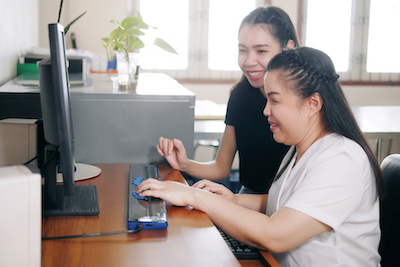By Dr. Amy S. Dufrane, SPHR
October embodies fall – full of apple picking, hayrides and pumpkin decorating. It’s also when we commemorate National Disability Employment Awareness Month (NDEAM). You might be wondering why I’m writing about it in November; the reason is straightforward. While it’s always good to create opportunities for employers and employees to collaborate on important initiatives, the fact is that NDEAM shouldn’t be a month on the calendar. It should be year-round.
Successful investor and CEO of Berkshire Hathaway, Warren Buffet, is attributed with saying, “Someone’s sitting in the shade today because someone planted a tree a long time ago.” Could a truer saying be relevant to the work we do in HR? It’s exactly why disability employment is important: according to the U.S. Bureau of Labor Statistics, about 21 percent of people with a disability in the U.S. were employed. That’s unacceptable, and we need to take the steps necessary to move that needle closer to the full employment range.
Data on persons with a disability gets collected as part of the Current Population Survey, a monthly sample survey of about 60,000 households that provides statistics on employment and unemployment in the U.S. Among the findings from 2022, the unemployment rate for persons with a disability was about twice as high as the rate for persons without a disability. Persons with a disability tend to be older than persons with no disability, and women are impacted more than men. A considerable proportion of persons with a disability are not in the labor force, which means their voices are not heard, and employers are not addressing their needs.
I know what a difference employment services and training can make for those with a disability. One of my passions is the Columbia Lighthouse for the Blind (CLB), an organization for which I’m the board Chair. Since 1900, CLB has been helping the blind – and far less obvious to those of us who are fully sighted – those individuals who are visually impaired. For employers, CLB provides services such as assistive technology – for example, screen readers – and worksite evaluations. For candidates, programs include vocational and situational assessments, resume support, and even travel training to navigate public transportation.
Fostering the fundamentals of NDEAM all year round involves the tree-planting experience referenced by Mr. Buffet. We have to start somewhere, and often we start with good intentions and a few seeds. Here are some actionable tips to consider when setting up your organization’s disability employment awareness commitment:
- Add disability to your Employee Resource Groups: members of this ERG can solicit ideas from managers, line up speakers and open the doors to qualified job seekers with disabilities.
- Host a disability mentoring day: whether through job shadowing, active mentoring or specific career development activities, connecting with talent – such as those in the CLB program – helps them and definitely helps you better understand how easily they can become valuable members of your team. Include a brown bag lunch to provide a chance for informal discussions.
- Reward volunteering: sponsoring activities at local organizations that prepare people with disabilities for work gives back and creates awareness. For example, consider having your hiring managers volunteer to review resumes and stage mock interviews.
- Don’t stop where it matters most: disability inclusion doesn’t stop when the person with a disability joins your company. A formal onboarding process complete with a mentor who understands and can reassure about reasonable accommodation procedures, helps new employees acclimate.
In the case of the visually impaired, CLB’s CEO, Tony Cancelosi, frequently reminds us of how truly amazing the results can be for both the employer and the employee. Independence is empowering, and the ability to work brings not only necessary monetary benefits but a deep sense of dignity. And today’s increasingly technological society means technology training can better prepare people for the job market whether they are blind, visually impaired or have low vision.
Recruiting and employing people with disabilities requires deliberate programs carefully designed to support them in the context of your business. Our labor market woes will continue unless we tap into new talent pools, and there’s one right in front of all of us: people with disabilities. Become an opportunity magnet by making the spirit of NDEAM month front and center in your organization’s year-round raison d’être.

